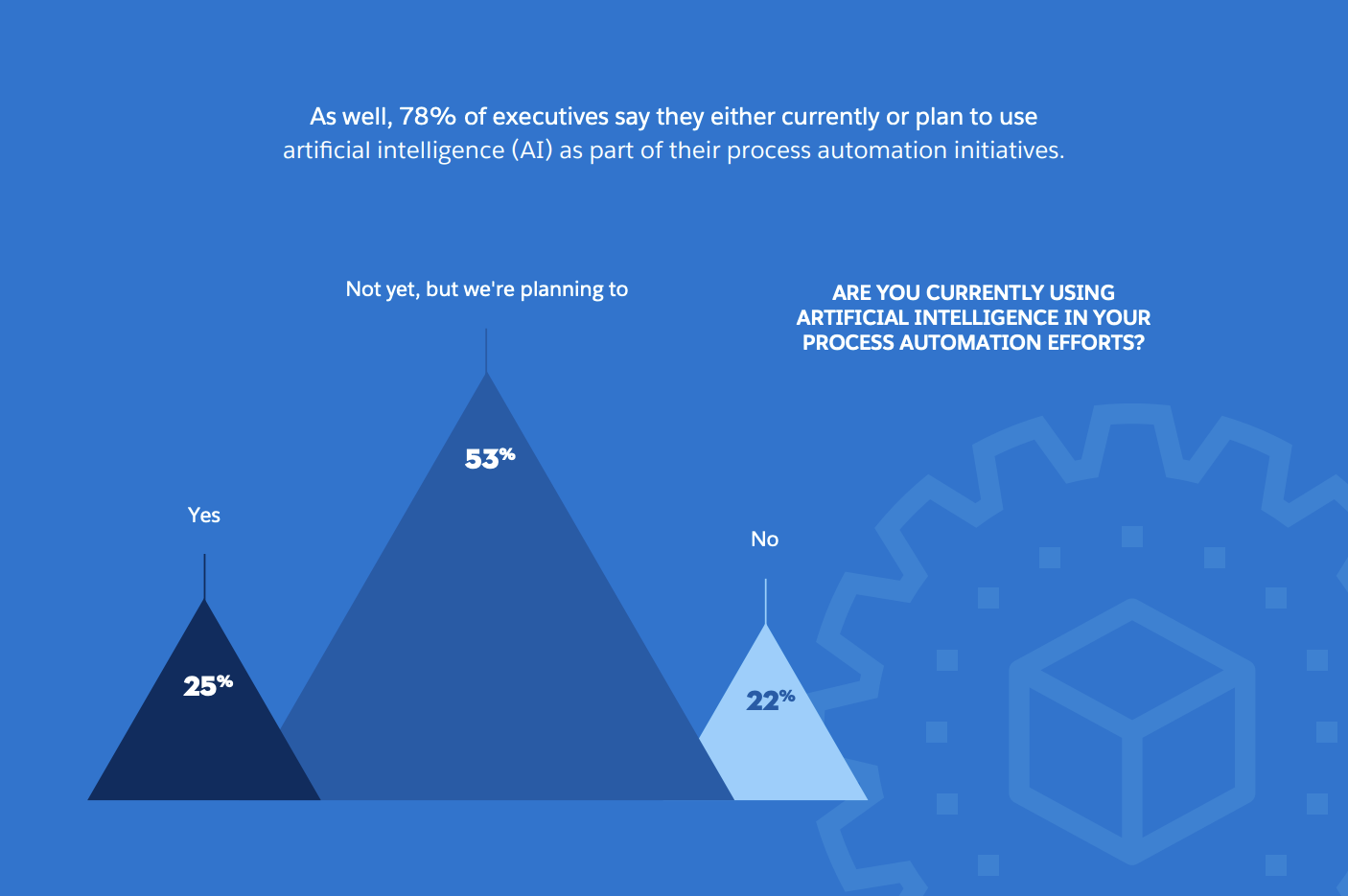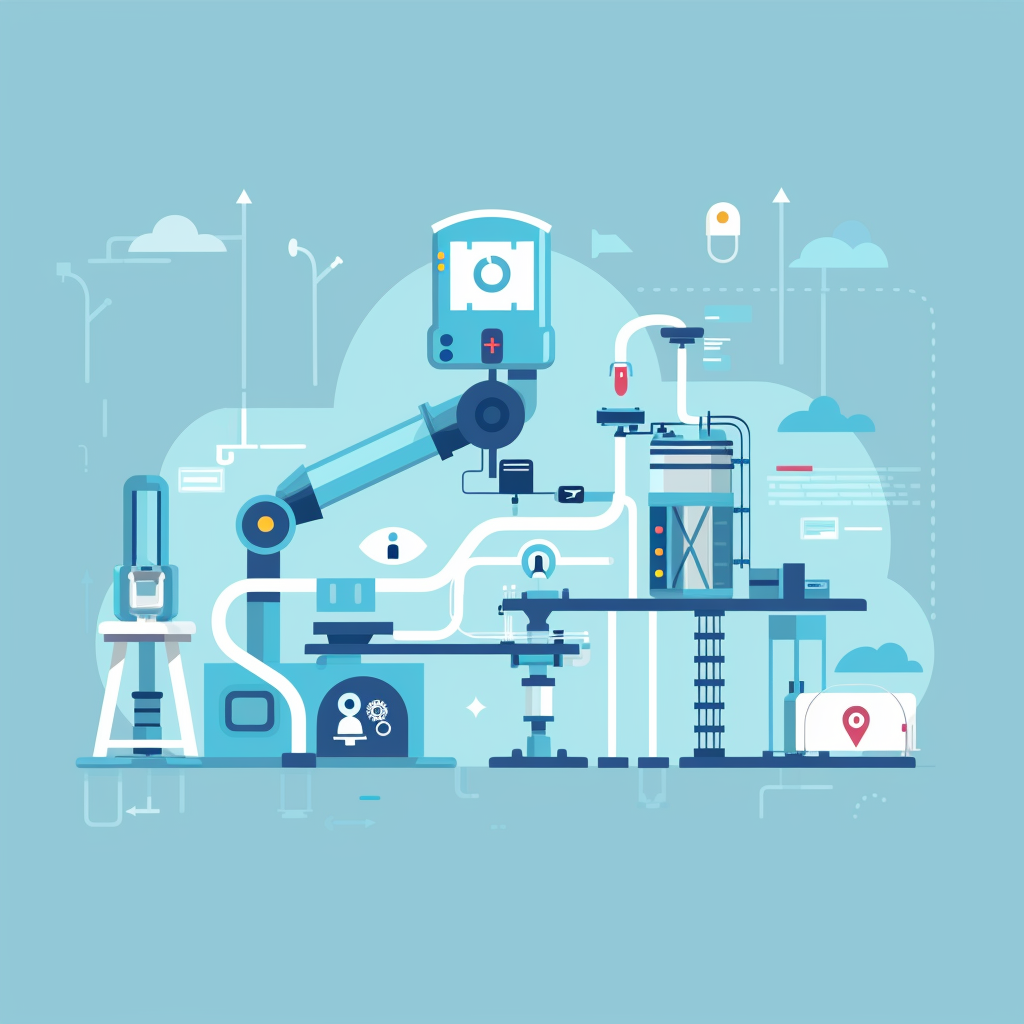The McKinsey Global Institute report revealed that up to 12 million jobs globally could be impacted by automation by 2030. This revelation underscored the urgent demand for innovative and streamlined solutions. Thus emerges the AI revolution: a transformative wave of workflow automation driven by artificial intelligence, reshaping the very fabric of organizational dynamics and heralding a new epoch of productivity.

Today’s business world moves fast, and being efficient is key. Doing repetitive tasks manually slows things down and eats up time that could be better used for important strategic plans. That’s where AI-powered workflow automation comes in, shaking up how organizations operate.
AI Workflow Automation: How It Works
AI workflow automation leverages the power of artificial intelligence to automate repetitive, rule-based tasks within defined business processes. It combines workflow automation tools with AI capabilities like machine learning and natural language processing (NLP) to handle complex tasks, analyze data, and make informed decisions, all while freeing up human resources for more strategic endeavors.
Here’s how it works:
- At the core lies AI, a broad term encompassing various technologies that mimic human intelligence. Machine learning, a key component of AI, allows systems to learn and improve their performance over time by analyzing data and identifying patterns. This enables AI to automate tasks that were previously considered too complex.
- AI workflow tools act as the engine, managing and facilitating the automated execution of tasks within defined workflows. They provide a platform for outlining the sequence of steps, assigning responsibilities, and ensuring smooth flow.
- NLP empowers AI to understand and respond to human language. This allows AI to process written or spoken communication, enabling it to handle tasks like generating reports, summarizing data points, or even interacting with customers through chatbots.
- AI workflow automation doesn’t replace human involvement; it augments it. While AI handles repetitive tasks, human expertise remains crucial for decision-making, complex problem-solving, and tasks requiring creativity and judgment. This collaborative approach optimizes resource allocation, allowing humans to focus on higher-value activities that leverage their unique strengths.
- An important point is that AI systems don’t operate in isolation since they continuously learn and improve. As they process more data and interact with the environment, they refine their decision-making capabilities and become more adept at automating tasks. This continuous learning cycle ensures the effectiveness and efficiency of AI workflow automation over time.

Benefits of AI Workflow Automation
Increased Efficiency and Productivity
Repetitive tasks, while essential, can create bottlenecks that hinder overall productivity. Imagine your team freed from these mundane tasks – that’s the power of AI. Imagine up to 30% more time for strategic thinking, creative problem-solving, and building genuine customer relationships.
For instance, in the healthcare industry, AI can automate tasks like scheduling appointments using AI scheduling assistants, processing insurance claims, and generating routine reports. This frees up doctors and nurses to dedicate their time to more complex patient interactions and personalized care.
Reduced Errors and Improved Accuracy
Humans are susceptible to errors due to fatigue, distractions, or even simple typos. AI, on the other hand, operates with unwavering consistency and precision. By automating data entry, calculations, and other repetitive tasks, artificial intelligence workflow significantly reduces the risk of human error, leading to enhanced data accuracy. This translates to improved financial reporting, streamlined customer service interactions, and better decision-making across the organization.
Better Data-Driven Decision Making
The age of big data is upon us, but extracting valuable insights from vast amounts of information can be overwhelming. AI comes to the rescue with its advanced data analysis capabilities. AI-powered tools can analyze mountains of data, identifying trends, patterns, and correlations that would be impossible for humans to discern.
These insights can then be used to inform strategic decision-making, leading to better resource allocation, improved product development, and even proactive risk mitigation. A study by Accenture revealed that 84% of executives believe AI will significantly impact their decision-making processes in the next five years.
Improved Customer Experience
AI can be harnessed to personalize and expedite the customer experience in numerous ways. Chatbots powered by AI can provide 24/7 customer support, answer frequently asked questions, and even resolve simple issues – all while freeing up human representatives for more complex customer interactions. Additionally, AI can analyze customer behavior and preferences, allowing businesses to tailor recommendations and offers to individual needs, leading to increased customer satisfaction and loyalty.
Cost Reduction
By automating repetitive tasks and optimizing workflows, AI can significantly reduce operational costs for your business. This includes minimizing labor costs associated with manual work, lowering error-related expenses, and improving resource allocation.
Moreover, harnessing AI technologies can reduce energy consumption and maintenance expenses by implementing predictive maintenance systems, which guarantee the optimal functioning of equipment and machinery. Additionally, AI has the capacity to enhance customer experiences on an individual level, fostering greater satisfaction and loyalty among customers. Consequently, this can yield long-term cost savings by bolstering customer retention rates and diminishing expenses associated with acquiring new customers.
Realizing the Potential: Workflow Automation Use Cases
AI workflow automation offers numerous benefits across various departments within an organization. So, what exactly can you do with AI workflow automation? Let’s delve into how different teams, particularly sales and marketing, can leverage AI-powered workflows to increase their efficiency and productivity.
Streamlining Sales Operations
- Lead generation. AI workflow automates lead generation processes, from identifying potential leads to initiating personalized outreach across multiple channels, saving valuable time for sales representatives.
- Follow-up management. Automated workflows ensure timely follow-ups with leads, which reduces the risk of missed opportunities and improves conversion rates.
- Task automation. Artificial intelligence workflow handles repetitive tasks like email writing and appointment scheduling, allowing sales executives to focus on building relationships and closing deals.
Enhancing Marketing Strategies
- SEO and content creation. AI workflow automation aids in keyword research, content structuring, and even generates initial drafts of articles. This empowers marketers to create SEO-friendly content efficiently.
- Social media engagement. Automated workflows optimize social media posting times and generate engaging content, boosting brand visibility and audience interaction.
- Thought leadership content. AI assists teams in generating diverse content formats, such as blog posts, social media updates, and video scripts. This, in turn, establishes thought leadership and expanding brand influence.

How to Automate Workflow with AI: Tips for Success
Integrating AI within your business is a calculated step, and implementing the following guidelines can aid in embracing effective strategies while sidestepping common mistakes.
Start with a Scalable Seed
Instead of simply starting small, plant a strategic seed for future growth. Choose a well-defined process that acts as a microcosm of your broader workflows. This initial automation serves as a proof of concept (PoC), allowing you to refine the approach and identify potential challenges before scaling it up to encompass more complex tasks. Remember, success breeds success; use this initial project to build momentum and showcase the value of AI within your organization.
Focus on User Adoption
Cultivate user engagement. Foster a sense of ownership and encourage active participation by involving stakeholders throughout the process. This can include co-creating artificial intelligence workflows, soliciting feedback during development, and empowering users to champion the solution within their teams. By fostering engagement, you not only ensure buy-in but also tap into the collective intelligence of your workforce, leading to more effective and user-centric AI workflow automation.
Prioritize Data Quality
Strive for data excellence. Implement robust data governance practices that not only ensure accuracy, completeness, consistency, and timeliness but also address potential biases and ethical considerations. Partner with data scientists to actively clean and refine your data and establish ongoing monitoring processes to maintain data integrity. Remember, data is the lifeblood of AI, and its quality directly impacts the effectiveness and ethical implications of your artificial intelligence workflows.
Monitor and Adapt
Embrace adaptive learning. View your AI workflows as living entities, constantly evolving through data feedback and user interaction. Utilize analytics dashboards to visualize performance metrics, identify areas for improvement, and fine-tune the algorithms accordingly. Encourage users to provide feedback on intelligent automation outputs, allowing the system to continuously learn and improve based on real-world experience.
Embrace Collaboration
Forge collaborative ecosystems to automate workflow processes. Break down silos between IT, business process owners, and end users. Foster a culture of open communication and shared ownership, where each stakeholder contributes their expertise to the overall success of the initiative. Encourage cross-functional teams to work together in co-creation workshops and brainstorming sessions, fostering a sense of collective responsibility and maximizing the impact of your AI efforts.
Overview of AI Workflow Tools
The landscape of AI-powered workflow tools is a vibrant ecosystem, constantly evolving to offer businesses an array of solutions for streamlining processes, boosting efficiency, and driving productivity across diverse industries. Here’s a deeper exploration of some leading examples, showcasing the multifaceted capabilities available in this rapidly expanding market:
User-Friendly No-Code Platforms
- Zapier: Zapier maintains its popularity with a user-friendly interface and an extensive library of pre-built integrations and triggers. It empowers users to connect various applications, automate workflows, and eliminate manual tasks, even with minimal coding knowledge.
- Integromat: Similar to Zapier, Integromat provides a no-code approach, allowing users to connect different apps and services, automate tasks, and build complex AI workflows, catering to a broad range of needs.
Enterprise-Grade RPA Powerhouses
- UiPath: Renowned for its advanced AI capabilities, UiPath stands tall as a leading enterprise-grade RPA platform. It utilizes computer vision and machine learning to automate complex processes, improving accuracy and reducing operational costs.
- Blue Prism: Another prominent player, Blue Prism, offers a robust solution for automating high-volume, repetitive tasks across various departments. Businesses can leverage this platform to streamline processes across different functions, enhancing overall efficiency.
AI-Driven Specialized Solutions
- IBM Maximo Manage: This cloud-based platform leverages AI for predictive maintenance and automated task management, specifically designed to optimize the lifecycles of assets.
- Automation Anywhere: This platform caters to a wider range of automation needs, offering not only RPA but also intelligent document processing (IDP) and cognitive capabilities. It empowers businesses to automate tasks across different functions, from customer service to finance, enabling a more holistic approach to automation.
Beyond the Examples
- Industry-specific solutions: The market is witnessing a surge in AI workflow automation tools tailored to specific industries like healthcare, finance, and manufacturing. These solutions address each sector’s unique challenges and needs, providing a more targeted and effective approach to automation.
- Continuous innovation: The field of AI workflow automation is a dynamic space, with constant advancements in technology and the emergence of new tools. Staying informed about these developments allows businesses to stay ahead of the curve and select the most suitable solution for their evolving needs.
Delving into the myriad options and remaining attuned to the ever-evolving landscape of AI workflow automation tools opens up a realm of opportunities for businesses. Through this exploration, organizations can revolutionize their operations, boost productivity, and pave the way for sustained success in the long run.
On a Final Note
Harnessing the power of AI for workflow automation empowers businesses to ascend to new heights of efficiency, precision, and productivity. These transformative strides equip organizations to prioritize strategic endeavors, optimize operational frameworks, and fortify their competitiveness within the dynamic fabric of contemporary business.
However, it is imperative to recognize that AI workflow automation is not a one-size-fits-all remedy. Meticulous planning, astute implementation, and relentless refinement are indispensable for unlocking its full potential and reaping the substantial rewards it promises.
As AI technology advances, its profound influence on our work methodologies and technological interaction is poised to deepen further. Embracing AI transcends mere adaptation—it signifies the cultivation of a more efficient, effective, and future-resilient workplace, thereby propelling organizational triumphs in the forthcoming era.



